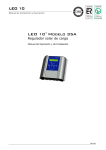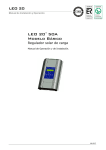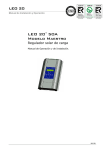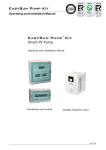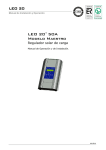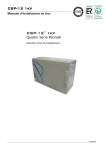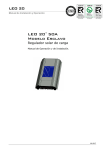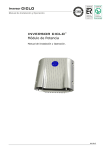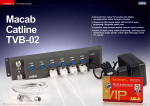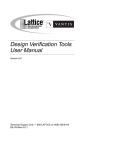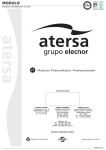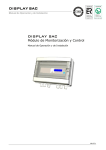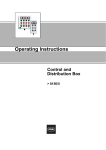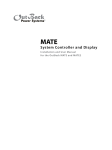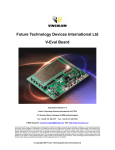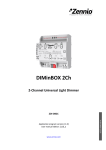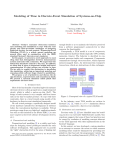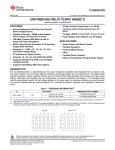Download 1 - Autosolar
Transcript
LEO 10 1 Installation and Operation Manual ER-0979/1/97 LEO 10 Model 35A Solar Charge Regulator Installation and Operation Manual E-MU-49-J 2 LEO 10 Installation and Operation Manual E-MU-49-J LEO 10 3 Installation and Operation Manual Introduction In the first place we, the people who have made this solar regulator possible, would like to thank you, the user for choosing the LEO10 for your photovoltaic installation. The LEO10 control and regulation system provides optimum load control and management of the accumulators of your photovoltaic solar systems, protecting all the elements of the installation. The design of this series of regulators responds to low and medium power systems for which no additional instrumentation is necessary. They are intended to implement a completely digital low-consumption regulation system that is reliable and flexible. The LEO family of regulators is available in different voltages and currents, according to the particular needs of each user. LEO10 regulators are available in two modes, bi-voltage 12/24V and 48V with operational values according to the models of 16, 25 and 35 Direct Current Amps. E-MU-49-J 4 LEO 10 Installation and Operation Manual E-MU-49-J LEO 10 5 Installation and Operation Manual Table of Contents Introduction ................................................................................... Table of Contents ............................................................................ Graphic Conventions Used ................................................................ Regulatory Compliance .................................................................... Safety Instructions .......................................................................... 3 5 7 8 9 Inspection sheet contained in the packaging ....................................... 10 Reception from Carrier.............................................................. 10 Contents of the Package ........................................................... 10 Equipment Description .................................................................... 11 Installation and start-up .................................................................. 12 A. Placement ............................................................................ 12 B. Equipment Attachment .......................................................... 12 C. Ground connection ................................................................ 12 D. Equipment Installation........................................................... 13 Regulation System ......................................................................... 16 A. Deep Charge ........................................................................ 16 B. Equalization ......................................................................... 16 C. High floating ........................................................................ 17 D. Low Floating......................................................................... 17 E. Night mode .......................................................................... 17 System protections ........................................................................ 18 A. Panel input short-circuit protection.......................................... 18 B. Consumption output short-circuit protection ............................. 18 C. Panel input overvoltage protection .......................................... 18 D. Over discharge protection ...................................................... 19 E. Overcurrent protection .......................................................... 19 F. Battery disconnect protection ................................................. 19 G. Inverse polarity protection ..................................................... 19 H. Overtemperature protection ................................................... 19 Alarm system ................................................................................ 20 A. Low battery voltage alarm ..................................................... 20 B. Consumption output disconnect alarm due to low battery voltage 20 C. High battery voltage alarm .................................................... 21 D. Overcurrent alarm ................................................................ 21 E. Over Temperature alarm ....................................................... 21 F. Short-circuit alarm ................................................................ 21 System menus .............................................................................. 22 A. Navigating through the menus ............................................... 22 B. Start menu .......................................................................... 23 C. Main menu ........................................................................... 27 D. Reset menu ......................................................................... 36 E. Lighting control menu ........................................................... 36 E-MU-49-J 6 LEO 10 Installation and Operation Manual F. Configuration menu .............................................................. 37 G. Short Cuts ........................................................................... 45 Table of Regulation voltages and process parameters ........................... 46 Technical Characteristics ................................................................. 48 Maintenance.................................................................................. 50 Quick Troubleshooting Guide ............................................................ 51 Annex 1. Lighting Control ................................................................ 53 A. Crepuscular Clock ................................................................. 53 B. Lighting Regulator ................................................................ 53 C. Configuration and Activation .................................................. 55 D. Lamp Menu .......................................................................... 56 Warranty Terms and Conditions ........................................................ 58 A. Duration of warranty ............................................................. 58 B. Conditions of warranty .......................................................... 58 C. Disclaimer............................................................................ 58 Trademark .................................................................................... 59 Modifications ................................................................................. 59 E-MU-49-J LEO 10 7 Installation and Operation Manual Graphic Conventions Used Throughout this manual, graphic symbols have been used to advise or inform the user of different situations of special importance. The symbology used and its significance is explained below. LIST OF GRAPHICAL CONVENTIONS: Symbol: Description: INFORMATION: Complementary description to bear in mind. Used as an important note or reminder. CAUTION: Situation that may cause serious damage to the equipment or minor injury to persons. DANGER: Notification of obligatory compliance. Disregard of the information referenced by this symbol may trigger an accident causing serious damage. INSPECTION UPON RECEPTION: Indicates the steps to follow upon opening the equipment packaging upon reception. USER: User manual. Handling of the equipment, menus, warnings and other functions. Installation and start-up. INSTALLER: Manual maintenance and supervision. Advanced Menu Options. E-MU-49-J LEO 10 8 Installation and Operation Manual Regulatory Compliance European Low Voltage Directive (LVD) 2006/95/CE European Electromagnetic Compatibility (EMC) 2004/108/CE o EN 55014-1:2000 o EN 55014-2:1997 Directive 93/68/EEC [CE Marking] Low Voltage Electrotechnical Regulation (RD 842/2002) (Note: more information on certifications can be obtained at www.atersa.com) E-MU-49-J LEO 10 9 Installation and Operation Manual Safety Instructions It is very important to read this section, the regulators use operating voltages, which are dangerous to persons This equipment uses dangerous voltages, it is very important to carefully read and follow the instructions that appear in this manual. Not following these instructions may have serious consequences, such as the destruction of the devices, personal injury or even death by electrical shock. This equipment must only be installed or opened by a trained qualified electrician and approved by the supplier. As a RULE: The battery is the first to be connected in the installation and the last to be disconnected to ensure good maintenance and eliminate errors. Disconnection of the battery, with the panel and/or consumers connected must be avoided. When starting battery connection in order to prevent short-circuits. 1. Connect the cables to the LEO10. 2. Connect the cables to the battery. Prior to carrying out any connection is necessary to check and ensure the polarity of the conductors. Take special care when handling the conductors in order prevent possible short-circuits. The installation of the equipment must be carried out as close as possible to the accumulators and separators on a vertical wall. The gases emitted by the accumulators may be explosive and/or corrosive; therefore it is important that the area has proper ventilation. The regulators act on the relays opening or closing the negative lines of the panel and consumption output. The positive lines are common to the panel, battery and consumption output. Grounding (see section on grounding) must be carried out keeping this circumstance in mind and referring at all times to the Low Voltage Electrotechnical Regulation. E-MU-49-J LEO 10 10 Installation and Operation Manual Inspection sheet contained in the packaging Reception from Carrier Inspect the product packaging prior to opening, verify that it is in acceptable condition. If it is damaged, immediately inform the delivery company or equipment supplier. It is important to remember that any damage report must be in writing and turned in to the delivery company within a maximum of six days. Contents of the Package Verify the contents of the package of your new LEO10 regulator. It should contain the following components: E-MU-49-J 1 LEO10 regulator. 1 Installation and Operation Manual LEO 10 11 Installation and Operation Manual Equipment Description The family of LEO regulators incorporates the latest generation of microcontrollers. This microcontroller uses a control algorithm capable of adapting to different daily situations quickly and effectively. Together, the solid state relay switching and the use of a high precision analogue/digital converter (for signal reading) offers the LEO family of regulators a high level of reliability and exciting new features. LEO regulators have been designed to charge common PbA (liquid electrolyte) and GEL (gelled electrolyte) accumulators. Additionally, the processing parameters may be customized for other types of accumulators (see the Configuration Menu Section). LEO regulators use a revolutionary algorithm, which integrates the regulator into the system and optimizes its load control and management tasks. This is accomplished by memorizing the system data, day after day, and allows us to monitor the evolution of the installation from the day when the LEO regulator was integrated into it. For input/output power switching tasks the regulators are equipped with solid state relays with low switching loss, instead of electromechanical relays. Additionally, they have been equipped with inverse polarity, overvoltage, overcurrent and shortcircuit protection. LEO regulators carry out accumulator maintenance automatically and electronically, thus extending their useful life. This equipment permits the configuration of the consumption output as a crepuscular lighting controller. Therefore, the regulator may be used to automatically control illumination at night. LEO regulators are equipped with a 2-line, 16 character display, which shows the system data clearly and orderly. E-MU-49-J LEO 10 12 Installation and Operation Manual Installation and start-up A. Placement The LEO10 regulators are to be placed in a vertical position (wall mounted) in order to facilitate heat dissipation by natural convection. Do not install near objects that prevent the flow of air through the rear heatsink. 200 mm 10cm 180 mm 10cm 135 mm 10cm Ø5 150 mm 10cm Figure 1 Electrical wires must not "pull" the regulator. They must be attached to the wall and as close as possible to the battery bank. The section and length of the wires are important so as to prevent loss from voltage dips. Voltage dips greater than 3% of nominal voltage under maximum amperage must be prevented. The LEO10 regulator and the battery bank must be installed in a place protected from the weather and which is cool, dry and ventilated to avoid accumulation of gases from the batteries. It should be easily accessible to the user but inaccessible to children and pets. B. Equipment Attachment Mechanical attachment of the equipment is very simple. The positioning and drilling is carried out using a stencil made for this purpose from the base of the equipment packaging or even from the equipment itself. C. Ground connection Only one point of the installation may be grounded. Choose only ONE of the following points: a. b. c. is Positive BATTERY terminal Negative BATTERY terminal If equipment that is connected to the consumption output of the regulator grounded, this shall be the only one to which it connects. E-MU-49-J LEO 10 13 Installation and Operation Manual D. Equipment Installation 1. Connect the cable from the negative terminal (-) of the regulator to the negative terminal of the accumulator. 2. Connect the cable from the positive terminal (+) of the regulator to the positive terminal of the accumulator. Figure 2 Pay attention to the polarity of the connectors 3. If the polarity is correct the equipment will emit three beeps. 4. The model of the LEO10 regulator and the software programming version will be displayed for 3 seconds. 5. The quick setup will be displayed for approximately 3 minutes (type of battery, system voltage, battery capacity). If the information shown is correct, push “YES ” (right key) If any parameter must be changed, push “NO” (left key) and then follow the instructions in Start up Menu section. Figure 3 E-MU-49-J LEO 10 14 Installation and Operation Manual 6. Connect the input cables of the panels and consumption output. Figure 4 Figure 5 The section of conductors is important in order to prevent possible voltage dips that may cause system malfunction. As a reference, voltage dips greater than 3% of nominal voltage under maximum amperage must be prevented. L = length of line in metres 2 Section (mm ) 2 L I MAX V IMAX= Maximum amperage +V= Maximum voltage dip T = Copper conductivity based on temperature. For example 70 = (*) Consult maximum amperage table from the cable manufacturer. E-MU-49-J 48; 90 = 44 LEO 10 15 Installation and Operation Manual 7. Once the consumption output is connected check the tightening of the twelve screws of the terminal strip: the six screws of the upper row (circuit attachment) and the six screws of the lower row (cable attachment). Carry out this check at least once a year. 8. The relay test menu will then appear. For valid testing, it is necessary that the panels are connected and generating power and that there is a minimum consumption of 10W. In this case push “YES” A relay status message will then appear. If the panel relays and consumption output are functioning correctly the message “OK” will be displayed. If there is a fault with either of the two, the message “Err”, will be displayed indicating that the corresponding relay cannot open and/or close correctly. In this case revise the installation connection or contact the Atersa technical service support. To finish, push the right key If conditions do not allow you to run the test (Because it is night time or because there is no consumption output connected) push “NO” in order to go back to the main menu. If you push “YES” under either of these conditions the LEO regulator will indicate that the panel or the consumption output is not connected by displaying the message “NC”. Figure 6 END OF EQUIPMENT INSTALLATION 9. When the installation is finished, observe the display and verify that the information shown is consistent. See the Main Menu Section. 10. The configuration needs only be carried out one time, upon installation. This is because it has been memorized in the equipment for the next time it is started up. NOTE: If upon connecting the equipment, no key is pushed for 3 minutes, the regulator will function under the last configuration used and will then go back to the main menu. E-MU-49-J LEO 10 16 Installation and Operation Manual Regulation System For the load control and management of the accumulators, the LEO10 regulators establish 4 phases for load processing using sophisticated algorithms in order to achieve maximum power transference from the panels to the accumulators. The LEO10 regulators measure the temperature, current and voltage of the accumulators in order to determine the final load voltage, achieving an optimum regulation process. Figure 7 Charge phases A. Deep Charge Deep charge is the first phase; the regulation system permits the input of a charge current to the accumulators with interruption until reaching the final voltage charge point. At this point, the accumulator has reached a charge level close to 95% of its total capacity. Once this voltage is reached, the regulation system establishes a battery voltage regulation band called deep charge maintenance (DCM). The DCM state achieves a small electrolyte pulsation of the accumulator in order to prevent stratification and sulfation of the internal plates. This state is maintained for a period of time, which is user configurable, by default of 2 minutes. After this interval, the regulators go into a High Floating phase. Liquid Electrolyte PbA accumulators may result in the acid density not being uniform over a period of time during which the charge has become low . This makes it necessary to shake it to prevent the stratification of the electrolyte and sulfation of the active plates. B. Equalization For liquid electrolyte PbA accumulators the regulators automatically apply an equalizing charge to extend their life. During this phase, a current is introduced for 3 hours, in order to fully charge all the battery elements so that they are equalized. For liquid electrolyte PbA accumulators, this equalisation is carried out each time 30 days have passed without a deep charge or when the adaptive algorithm determines that equalisation is necessary in order to compensate for over discharges of the accumulators. This charge phase is not carried out with Gel type accumulators. E-MU-49-J LEO 10 17 Installation and Operation Manual C. High floating The high floating phase attempts to maintain the battery voltage constant while carrying out the final charge phase of the accumulators. This phase is maintained for a period of time that will depend on the history of the system's usage, varying between 5 minutes for infrequently used installations with the battery fully charged from up to 4 hours, to situations in which the battery has been at a very low charge for a long time. This adjustment, which we call historic, is completely automatic and is carried out by an adaptive algorithm that takes into account the particular operating characteristics of the installation. There is an operation area of the regulation system established within which we call the "High Floating Band". The HFB has a voltage range whose maximum and minimum values are fixed between the final charge voltage and the nominal charge voltage. D. Low Floating At this point the accumulators are completely charged. A low current is introduced in order to "maintain" the charged accumulators, compensating for any automatic discharge effect. E. Night mode The LEO10 regulators detect when it is getting dark. To accomplish this, the regulators carry out measurements of the panel input voltage each 5 minutes. In this state, the regulators disconnect the panel relays in order to prevent current leaks from the batteries to the panels. This is also called "blocking diode function". E-MU-49-J LEO 10 18 Installation and Operation Manual System protections The LEO10 regulators incorporate every type of operating protection against overload, overvoltage, short-circuits or low voltages in order to protect the regulators themselves as well as all equipment that may be connected to them; panels, batteries, consumption output, etc. The following details the different types of protections the regulators offer. A. Panel input short-circuit protection When a short-circuit is detected at the panel input, the LEO10 regulators immediately open the panel relay, isolating the short-circuit from the rest of the system thus protecting the regulation system and all connected elements. The LEO10 regulators automatically reset after resuming normal operation. When the LEO10 regulators are started for the first time, the panel input relay remains open, thus preventing any possible short-circuits at the panel input during installation. B. Consumption output short-circuit protection When a short-circuit is detected at the consumption output, the LEO10 regulators immediately open the consumption output relay, thus protecting the regulation system against high currents. The LEO10 regulators automatically reset, attempting to reconnect (approx. each 10 seconds) so that if the short-circuit disappears the user will regain power immediately. C. Panel input overvoltage protection The LEO10 regulators have been designed for different operating voltages (12/24 bi-voltage). After each system reset (connection of the regulators to the battery) the nominal voltage of the connected battery is automatically detected, thus establishing the maximum allowable voltage limits. In the case of voltage greater than that specified for the particular LEO10 model, the battery charge process will be interrupted via the solar panels. Overvoltages may also occur during thunderstorms, due to lightning near the installations, therefore varistors have been installed, which absorb the overvoltages and protect the elements connected to the LEO10 regulators. This type of protection permits the absorption of approved levels of overvoltage. Protection is not guaranteed for direct lightning strikes on the installations. E-MU-49-J LEO 10 19 Installation and Operation Manual D. Over discharge protection The LEO10 regulators protect the accumulators against over discharges by establishing a minimum charge level (SOC) around 20% of the accumulators' nominal capacity. In the event of exceeding this threshold, the consumption output automatically disconnects. The reconnection of the consumption output is automatic when the minimum reconnection voltage is reached. This occurs when the accumulator is recharged. For the precise disconnection voltage calculation of the consumption output, the LEO10 regulators make calculations in order to compensate for discharge based on the current absorbed by the consumption output. E. Overcurrent protection In the case of overcurrents due to overload (panel to battery line), or due to over consumption (battery to consumption output line), the LEO10 regulators interrupt the charging and/or consumption process in order to protect itself and the other elements connected to the regulators. F. Battery disconnect protection In the case of battery disconnection, voltages may reach dangerous levels (panel voltage). In this case, the panel input and consumption output relays open in order to protect the consumption output. If the accumulators reconnect and the voltage falls to within the established limits, the regulators will reconnect the relays and continue with the normal charging process. G. Inverse polarity protection In order to protect against inverse polarity of the battery terminals, the regulators will not start and their relays (panel and consumption output) will remain open, protecting the internal control. In order to protect against inverse polarity of the panel input, the LEO10 regulators will keep the panel relay open and in night mode charging status. H. Overtemperature protection In the case of excessive temperature increase in the interior of the LEO10 regulators, the system will be protected by opening the charge and consumption output relays in order to reduce the internal temperature, automatically reestablishing regulation control of the system when the internal temperature range is acceptable. E-MU-49-J LEO 10 20 Installation and Operation Manual Alarm system The LEO10 regulators incorporate an advanced detection system for abnormal operating situations. In an alarm situation the user will be alerted by a repetitive audible signal. The alarm display on the main menu will show the active alarm with the highest priority. The alarm will remain activated for as long as the alarm situation persists. The audible signal may be silenced by pushing any key on the touch pad. NOTE: Cancelation of the buzzer acts only on the audible signal. The alarm messages will remain on the display. The buzzer used for the audible alarm is lowconsumption therefore it is not important if it is connected for a prolonged period of time. A. Low battery voltage alarm The low battery voltage alarm indicates that the accumulator has a low charge. From this charge level, the accumulator conditions begin to be compromised. If the battery voltage falls below the alarm threshold value for a certain amount of time (10 second by default, user configurable) the low battery voltage alarm is activated. If, despite the alarm, the battery continues discharging, the consumption output will disconnect due to the voltage being excessively low. B. Consumption output disconnect alarm due to low battery voltage This alarm is associated with the "over discharge protection", which disconnects the consumption output. This intends to stop the battery discharge in order to prevent its deterioration. The consumption output disconnect alarm due to low battery voltage indicates an over discharge of the accumulator. If the battery voltage falls below the disconnect alarm threshold for a certain amount of time (10 second by default, user configurable) the consumption output disconnect alarm due to low battery voltage is activated. This established timing prevents short-term overloads, such as starting a motor, to activate the alarm. E-MU-49-J LEO 10 21 Installation and Operation Manual C. High battery voltage alarm The high battery voltage alarm is activated when the accumulator voltage becomes excessively high. When this occurs, the consumption output is deactivated. This situation is due to the charge relay not functioning properly or because the battery is charging by other means (external charger with electric generator group) with a regulation malfunction. D. Overcurrent alarm The overcurrent alarm is activated when the equipment detects an overcurrent either in the panel input or in the consumption output. The overcurrent must last for a certain amount of time in order to activate the alarm (5 seconds by default, user modifiable). The alarm will automatically disappear once the anomaly has been corrected. E. Over Temperature alarm If the equipment is operating in temperatures which are too high, (consult Table 4: Technical Characteristics) the over temperature alarm will activate. It may be necessary to condition or relocate the regulators so that the working environment is more suited to the technical specifications. F. Short-circuit alarm This alarm indicates that there is a short-circuit in either the panel input or the consumption output. The alarm is activated immediately upon detection of any malfunction and automatically disappears once the problem has been corrected. E-MU-49-J LEO 10 22 Installation and Operation Manual System menus The LEO10, model 35A regulators incorporate a 4-key touch pad, which permits navigation through the menus. Figure 8 A. Navigating through the menus In order to navigate through the menus, there is a 4-key touch pad (left, up, down and right). Figure 9 Additionally, on occasion, there will appear on the display two different types of arrows: The character ">", on the right of the display, indicates that there is more information related to the current display, which may be accessed by pushing the right key on the touchpad. The character "->" indicates that the data entered may be validated or that the action shown on the display may be executed by holding down the right key on the touchpad. The key must be held down for 5 seconds or until a second beep is heard. The characters: “:>” to the right or to the left “<:” on the display indicates that it is possible to enter or leave the main menu display. E-MU-49-J LEO 10 23 Installation and Operation Manual B. Start menu Figure 10 E-MU-49-J LEO 10 24 Installation and Operation Manual 1 Welcome display The welcome display is only shown upon start-up of the LEO10 regulators. It shows the model of the LEO10 regulator and the equipment firmware version. L EO 10 MOD .35 A VER X.X.X Figure 11 2 Configuration validation display The LEO10 regulators allow configuration of the most important characteristics of the accumulator so that the regulation is as effective as possible. This display automatically appears when the accumulator is connected to the LEO regulator. The LEO10 regulators remembers the last configuration entered, meaning that in the case of disconnection or shutoff and then reconnection, the last user defined configuration will be re-established without having to reconfigure it. If nothing has been configured, the regulators use the predefined factory values by default. (See Adjustment processes section) Current configuration Change configuration Accept configuration Figure 12 If no key has been touched, after connecting the regulator to the accumulator, within a few minutes, the last configuration values will be initiated and then will go the main menu. Selection of process type In order enter your installation accumulator type. Figure 13 E-MU-49-J LEO 10 25 Installation and Operation Manual Selection of nominal voltage In order to enter the nominal voltage of the system: Figure 14 Selection of Accumulator Capacity Figure 15 In order to enter the accumulator capacity, select the value, increasing/decreasing by using the up/down keys. By holding the key down, the values jump in increments of 10 units. Once the desired value is displayed, press the right key in order to validate it. Relay test display This permits the panel and consumption output relay status to be checked. For valid testing, it is necessary that the panels are connected and generating power and that there is a minimum consumption of 10W. Figure 16 E-MU-49-J LEO 10 26 Installation and Operation Manual When carrying out the relay TEST, the display will show the test results and will indicate the current status of the panel and consumption output relays: OK ERR NC Figure 17 If the statuses of the relays are correct, OK will appear on the display. If Err appears on the display, it means that there is an error in the corresponding relay. This may be due to a fault in the relay or a fault associated with the installation; check the wiring. Figure 18 If the initial specifications are not met (panels connected and generating and the consumption output connected with at least 10W of power) the LEO10 equipment will display the message “NC” (Not connected), indicating that the corresponding relay does not have the minimum conditions for verification. Figure 19 E-MU-49-J LEO 10 27 Installation and Operation Manual C. Main menu The main menu shows the most significant information of the charging process of the accumulators, as well as the consumption output, internal and external temperatures, alarms, etc. * * Figure 20 E-MU-49-J LEO 10 28 Installation and Operation Manual 1 Main display The main display shows the state of charge (SOC) of the accumulators, the average battery voltage (B), the average charge amperage and the average amperage supplied to the consumption output; averages calculated per second. State of charge (SOC) Average amperage of panel S O C :5 0 % B :14 .6 V 0 0 1.6 A x [ ]-> 0 0 .8 A Average battery voltage Average amperage of consumption output Pictograms of relay status Figure 21 For more details on the SOC, see the State of Charge display (SOC) section The central part shows a pictogram representing the battery charge and consumption output relay control status. Figure 22 The symbol on the left refers to the battery charge control status: -> [] X [] o [] Panel current input Panel disconnected Panel current very low or null The symbol on the left refers to the consumption output control status: [] -> [] X [] o Current output to Consumption Output Consumption output disconnected Consumption output current very low or null If your LEO10 regulator disconnects any active alarm, the center symbol will alternate with the symbol to indicate that there is a problem with your installation. Consult the Alarm Display section (point 9) in order to identify the type of problem. The symbol will remain while the activated alarm persists. When the alarm is corrected the symbol will return to its initial value. E-MU-49-J LEO 10 29 Installation and Operation Manual 2 Charge display Panel voltage A.h. generated in the last 24 hours P A N 14 .6 V 0 1.6 5 A 0025.8Ah 00 C2 > Average amperage of panel input State of charge and relay No. of total panel disconnection per alarm Figure 23 The charge display shows: Vac voltage of the panel. Last voltage measured on the panel terminals when the relay is open. Average amperage of panel input. Amps per hour on the panel input, measured by the regulator (last 24 hours). Total number of times the panel has disconnected, due to alarm situations. Status of panel relay : A = Panel relay open, amperage flow not permitted. C = Panel relay closed, amperage flow permitted from the accumulator. State of charge. Provides more information on the charging process. The following lists the possible states: 1 = Night. 2 = Charging. 3 = Deep Charge. 4 = Equalization. 5 = High floating. 6 = Low floating. 7 = Battery not detected or very low charge. 8 = High battery charge. 9 = Over amperage. Example C2 = Panel relay closed; state "charging" All of these case are explained in greater detail in the Regulation system Section. By pressing the right key the panel registry (data history) of maximum voltage and current levels from the time the equipment is connected may be accessed. PA N VM A X: IM A X : < 1 5 .3 V 3 5 .12 A Figure 24 E-MU-49-J LEO 10 30 Installation and Operation Manual 3 Consumption output display Average battery voltage A.h. consumed in the last 24 hours C O N 14 . 5 V 0 0 .8 1 A 00 01.8Ah 00 C2 > Average output amperage Relay and consumption output status No. of total disconnections of the consumption output per alarm Figure 25 The consumption output display shows: Average battery voltage. Average battery voltage measured by the regulator, averaged in seconds. Average output amperage in the last second. Output amps per hour, measured by the regulator. Total number of times the consumption output has disconnected, due to alarm situations. Status of consumption output relay : A = Consumption output relay open, disconnected. C = Consumption output relay closed, connected. State of consumption output. Provides additional information consumption output control. The following lists the possible states: on the 2 = Consumption output connected 3 = Low battery voltage 4 = Consumption output disconnection due to low battery voltage 5 = Consumption output disconnection due to high battery voltage 6 = Consumption output disconnection due to overcurrent to the consumption output. Example C2 = Consumption output relay closed and consumption output connected All these case are explained in greater detail in the Regulation system Section. By pressing the right key the maximum voltage levels and consumption output current log from the time the equipment is connected may be accessed. CO N V M A X: IMA X: < 1 5 .2 V 10 .12 A Figure 26 E-MU-49-J LEO 10 31 Installation and Operation Manual 4 State of Charge display The state of charge allows you to estimate the charge level of the connected battery. Keep in mind that it is important to correctly configure the capacity parameters of the accumulator so that this field presents valid information. Figure 27 The range of the SOC indicator will vary between 0% (battery completely discharged) and 99% (battery fully charged). After starting the regulators, the SOC level is undefined as it has no information from the previous charge of the battery. By default the SOC is established at 50%. It is necessary to carry out at least one full charging of the battery so that the SOC shows useful information. NOTE: The state of charge is an approximation of the accumulator charge level. It is possible that the value presents discrepancies regarding the real charge percentage of the battery, if: The nominal capacity of the accumulator is incorrectly configured. A charge and/or consumption output is connected directly to the battery without going through the regulator. The battery has deteriorated and its behavior or nominal capacity has been modified. No deep charge of the accumulator has been carried out. The equipment will show the battery charge evolution or tendency of the day. Figure 28 This value lets you compare the charge status of the battery with respect to the previous day. Positive values indicate that the battery has been charged and a negative value indicates that the battery has been discharged with respect to the previous day. This display will alternatively be shown along with the display that indicates the state of charge for the accumulator once 24 hours have passed since the start-up of the regulator. 5 State control display The LEO10 regulators take into consideration the different control devices that regulate the system processes. This display details the most useful process information for the user. Panel Consumption output Figure 29 Connected Low voltage Disconn LowVolt Disconn HighVolt Disconn HighAmp Light ON Light OFF Charging Night Deep Charge Equalization High floating Low Floating No battery High voltage Overvoltages E-MU-49-J LEO 10 32 Installation and Operation Manual The state of charge of the system is shown on the upper line of the display; the possible options are: Night. In this state the panel relay remains open in order to prevent inverse currents in the panels and that they consume power from the accumulator during the night. This state is maintained until the panel voltage is greater than the battery voltage. The regulators, by default, start up in "night mode" in order to prevent short-circuits in the panels due to a bad connection. Charging. This state indicates that the photovoltaic panels are generating enough power to charge the accumulators and are therefore, charging the battery. Deep Charge. This state is maintained for a few minutes (2 minutes by default) in order to move the electrolyte in the accumulator. The deep charge process is carried out daily. Equalisation . In this state, a voltage slightly higher than that of the deep charge is introduced in order to equalize the charge in all the vessels of the accumulator. By default, this is carried out in Lead-Acid type batteries every 30 days (user configurable). High floating. This state corresponds to the final charge phase of the accumulators. Low floating. This state indicates when the accumulators are fully charged and their voltage is stabilized. Then, a low current is introduced in order to keep the accumulators charged. No Battery. This state indicates that no accumulator is detected or that the voltage is dangerously low. This causes the panel input and the consumption output to disconnect. High floating. This state indicates that an excessively high voltage level has been detected in the accumulator. This causes the panel input and the consumption output to disconnect. Over amperages. This state indicates an over amperage of the input current from the panel. This causes the panel input to disconnect. The state of charge of the consumption output is shown on the lower line of the display; the possible options are: Connected. This state indicates that the consumption output is connected. Low voltage. This state indicates low voltage in the battery. Disconn. LowVolt. This state indicates disconnection of the consumption output due to low battery voltage. Disconn. High Volt. This state indicates disconnection of the consumption output due to high battery voltage. Disconn. High Amp. This state indicates disconnection of the consumption output due to high current to the consumption output. Light ON. If the lamp control is enabled and the output is activated, this message is displayed, provided there are no alarms. Light OFF. If the lamp control is enabled and the output is deactivated, this message is displayed, provided there are no alarms. All of these states are presented in greater detail in the Regulation System section. E-MU-49-J LEO 10 33 Installation and Operation Manual 6 Process display Figure 30 The process display shows the most important configurable parameters of the installation: Accumulator type: PbA / GEL / Personalized Nominal voltage of the accumulator, auto-detectable upon start-up for the 12/24V bi-voltage and 48V models. Nominal capacity of the accumulator. 7 Temperature display Shown on the display: T E M P T E X T : T IN T : OK 23.5º 24.1º Figure 31 System status. If the system is working within a safe operating range, the LEO10 regulator will show OK on the display. Upon exceeding the safe temperature threshold the system will indicate the Err alarm on the display. External Temperature. This shows the external temperature in centigrade in the event that the external temperature sensor has been installed. If no sensor has been installed the message ErrNC, sensor not correct, will be displayed. If there is a short-circuit in the sensor, the message ErrCC will be displayed. This sensor is not supplied with the regulator. Internal Temperature. This shows the internal temperature of the LEO10 regulator in centigrade. 8 Serial number display This display shows the manufacturer serial number, which identifies the equipment. Figure 32 9 Alarm display In order to visualize the alarms, three sub displays have been equipped, which show the active alarms and the number of times they have appeared in the system. Figure 33 E-MU-49-J LEO 10 34 Installation and Operation Manual The first display shows the description of the alarm with the highest priority over all the other active alarms. High battery voltage alarm. Low battery voltage alarm. Battery discharge alarm. Consumption output and/or panel over amperage alarm. Regulator over temperature alarm. Battery not detected alarm. Panel short-circuit alarm. Consumption output short-circuit alarm. By default, if there are no active alarms on the LEO10 regulator it will display "No Alarms", as shown in the Figure 33. The other alarm displays allows the user to see the active alarms in greater detail. Below each alarm identifier the current status is shown: C. Correct. Alarm not active. A. Alarm. Alarm currently active. The alarm is followed by an individual counter of the alarm type. The LEO10 regulators are equipped with sophisticated weighted registry algorithms for alarm events so that they are capable of showing both current and past alarms. The history of each alarm shows the number of times the alarm has occurred on the registered days. The number will always refer to a maximum of the last 10 days registered. It is possible to reset the registered day counter in order to begin counting the system alarms from this moment; see Registry V Display. Each alarm has its own two-digit alarm counter. This counter allows storage of up to 99 alarms. Alarm display I: Figure 34 Alarms for: E-MU-49-J High battery voltage (HV) Low battery voltage (LV) Consumption output disconnect due to low battery voltage (DC) LEO 10 35 Installation and Operation Manual Alarm display II: Figure 35 Alarms for: High regulator temperature (HT) Panel and/or consumption output over amperage (OA) Battery disconnect or under voltage (BD) Alarm display III: Figure 36 Alarms for: Panel and/or consumption output short-circuit (SC) Process IV counter display: Figure 37 Indicators of: Deep charge (DC) No. of times a deep charge has been carried out. Number of nights (NN); No. of times the system has entered night mode. Registry V display: Figure 38 This display indicates the number of days registered by the system. The values shown on the counters are the result of the alarms produced during the n days of the registry, shown on this display. The window of alarm storage will show a maximum of 10 days. The user may manually reset the counters by pressing the right key . The reset also initializes the maximum values of the panel and consumption output. E-MU-49-J LEO 10 36 Installation and Operation Manual D. Reset menu The LEO10 regulators allow you to reinitialize the system from the touch pad. The values stored in the registry will not be modified. For security reasons, accessing the LEO10 regulator configuration menu is only permitted using a password. This is done by holding down the three keys on the right side from the Main Display of the menu. The key menu may not be accessed from any other display. Figure 39 Next, enter the code “0004”. In order to enter a password, press the navigation keys to compose the corresponding number. Figure 40 You will now access the reset menu, press YES if you wish to reinitialize the equipment. Figure 41 E. Lighting control menu The LEO10 regulators allow you to configure the consumption output as a lighting control. If this feature is activated, when it gets dark, the output will be activated at the maximum time configured by the user, distributed in minutes to come on after it becomes dark and minutes before sunrise. If it is unable to provide all the time requested by the user, the regulation algorithm will provide the lighting time of the lamp based on the battery charge. Revise Annex 1. Lighting Control for more information. If you wish to activate the lamp using the configuration stored in the memory you can use the short cut to activate/deactivate the lamp. To do this, simultaneously press the left and down keys on the regulator touch pad. Figure 42 If you wish to modify any of the parameters, access the General Adjustments menu from Configuration Menu. For more information regarding configuration, see Annex 1. Lighting Control. When the lamp is active, 3 new displays will appear in the main menu with information regarding the status and control of the lamp, consult Annex 1. Figure 43 E-MU-49-J LEO 10 37 Installation and Operation Manual F. Configuration menu Figure 44 For security reasons, accessing the LEO10 regulator configuration menu is only permitted using a password by holding down the three keys on the right side from the Main Display of the menu. The key menu may not be accessed from any other display. IN T RO D U CIR CL AV E 00 0 2 -> Figure 45 E-MU-49-J LEO 10 38 Installation and Operation Manual Next, enter the code “0002”. In order to enter a password, press the navigation keys to compose the corresponding number. Press: Left to move the digit to the left. For example, move units placed in units of ten (0000 --> 0000) Right to move the digit to the right. Once selected the unit digit to the right blinks briefly and exits the menu without accepting the code. For example, placed in the tens, push this key to move the digit to the tens (0000 --> 0000) Up this increases the digit unit selected. For example, placed in the tens, when this key is pushed it will increase this unit (0051 --> 0061) Down this decreases the digit unit selected. For example, placed in the units, when this key is pushed it will decrease this unit (0081 --> 0071) Be default, the display will indicate the value 0000 and the digit corresponding to the unit will be selected. In order to accept the entered code and to access the corresponding menu, hold down the right key (for 3 seconds or until you hear the second short beep) E-MU-49-J LEO 10 39 Installation and Operation Manual 1 General adjustments Figure 46 After accessing the General Adjustment menu (key ) the upper line of the display will show the description of each of the modifiable parameters in this submenu. Each parameter is identified by Pxx, where xx represents the parameter number. To edit the values shown in this submenu: 1. Select the parameter you wish to modify. Navigate using the up and down keys until you find the parameter. 2. Press the right key to Exx. to modify the value. The identifier Pxx will change 3. To modify the parameter. Increase or decrease the value using the up and down keys. 4. Validate the changes by holding down the right key. 5. E-MU-49-J LEO 10 40 Installation and Operation Manual The menu General Adjustments allows you to establish general adjustment parameters for the regulator, such as: Num. Label Unit Default value P00 Com. Node - - P01 Language - 0 P02 Activ. Sound - 1 P03 Activ. Alarm - 1 P04 Disconn. Consumption output - 0 P05 Num. Esclav - 0 P06 Activ. lamp - 0 P07 Lamp reg. - 1 P08 Sundown (Min) 300 P09 Sunrise (Min) 60 Description Number of external communication nodes System language 0.Spanish / 1.English Activ. / Deactiv. the sound of the touch pad and alarm: 0.Deactivated / 1.Activated Activ. / Deactiv. the sound of the alarm: 0.Deactivated / 1.Activated Activ. / Deactiv. consumption output relay: 0.Deactivated / 1.Activated Not applicable to the LEO10. Activation of consumption output as lighting control. 0. Deactivated Normal consumption output. 1. Activated Consumption output lamp. Internal Do not modify Lamp start-up minutes after sundown. Lamp start-up minutes before sunrise. Table 1 2 Process Settings USE ONLY BY QUALIFIED PERSONNEL. This allows for the modification of operating voltages, capacity, times, etc. in order to configure installations that require special values. After accessing the Process Settings menu (key ) the upper line of the display will show a description of each of the modifiable parameters in this submenu. Each parameter is identified by Pxx, where xx represents the parameter number. E-MU-49-J LEO 10 41 Installation and Operation Manual Figure 47 To edit the values shown in this submenu: 1. Select the parameter you wish to modify. Navigate using the up and down keys until you find the parameter. 2. Press the right key to modify the value. The identifier Pxx will change to Exx. 3. To modify the parameter. Increase or decrease the value using the up and down keys. 4. Validate the changes by holding down the right key. The menu "Process Settings" allows you to establish regulation settings, storage and process parameters, such as: Num. Label Unit Predef. Value 12/24/48 V Description This parameter configures the regulation system in order to operate under one of the three available configurations: 0 Config. process base - PbA 1 2 VBat Bat. Cap. (V) (A.h.) 12 / 24 / 48 500A.h. 3 Bat Type - Lead-acid 4 Upp. Equ. (V) 5 Low. Equ. (V) 6 Upp. DC (V) 15.2 / 30.4 / 60.8 15.0 / 30.0 / 60.0 14.8 / 29.6 / 59.2 PbA type . Predefined configuration for lead-acid accumulators. GEL type. Predefined configuration for gel electrolyte accumulators. Personalized: Allows you to modify the default parameters of the previous configurations. Nominal battery voltage. Total battery capacity Battery type: Lead-acid / GEL Upper threshold in equalisation state. Lower threshold in equalisation state. Upper threshold in deep charge state. E-MU-49-J LEO 10 42 Installation and Operation Manual Low DC (V) 8 Upp. DCM (V) 9 Low DCM (V) 10 Upp. HF (V) 11 Low. HF (V) 12 Upp. LF (V) 13 Low. LF (V) 14 Days of Equ. (days) 30 15 Equ.Time (Min) 180 16 DCMTime (s) 120 17 HFTime (Min) 120 18 Max BVolt (V) 19 ConsAlrm. (V) 20 Cons.Discon. (V) 21 ConsRecon. (V) 12,6 / 25.2 / 50.4 22 DisconBVolt (V) 9.5 / 19.0 / 38.0 23 AlrmTime V (s) 10 24 AlrmTime I (s) 5 25 I Ext A/60mV. - 150 26 Aux. A/D sel. - 1 27 Comp. T, C, A. 28 Comp. SOC 29 E-MU-49-J 14.7 / 29.4 / 58.8 14.8 / 29.6 / 59.2 14.7 / 29.4 / 58.8 14.1 / 28.2 / 56.4 14.0 / 28.0 / 56.0 13.7 / 27.4 / 54.8 13.6 / 27.2 / 54.4 7 Adap. Charge 15.6 / 31.2 / 62.4 11.8 / 23.6 / 47.2 11.6 / 23.2 / 46.4 1 - 0 2 Lower threshold in deep charge state. Upper threshold in DC maintenance state. Lower threshold in DC maintenance state. Upper threshold in high floating state. Lower threshold in high floating state. Upper threshold in low floating state. Lower threshold in low floating state. Num. of days between equalisations (only for PbA type batteries). Total duration of equalisation phase. Total charging time in deep charge maintenance state. Charging time in high floating state. High voltage alarm and disconnect threshold. Low battery voltage alarm threshold. Consumption output under voltage disconnect threshold. Consumption output reconnect threshold after disconnection due to low battery voltage Battery not connected detection threshold. Maintenance time for voltage alarm situation, before producing alarm. Maintenance time for amperage alarm situation, before producing alarm. A/60mV ratio for lexterna gain (auxiliary shunt). Input selector for A/D conv. 0.None| 1.BVat ext | 2.Iexterna | 3.VBat ext + Iexterna Compensation for temperature, capacity and amperage: 0.Deactivated / 1.Activated SOC compensation by charge or discharge Cx: 0.Deactivated / 1.Activated Selection of charge algorithm: 0. Fixed charge without equalis. 1. Fixed charge with periodic equalisations, in accordance with parameter no. 14. 2. Adaptive charge algorithm per historic control: equalisation and dynamic floating. LEO 10 43 Installation and Operation Manual 30 VDsc. GE V 14.8 / 29.6 / 59.2 31 TDsc. GE (Min) 0 Disconnect voltage of the electrical generator group (only for the LEO20). Disconnect time of the electrical generator group (only for the LEO20). Table 2 3 System data Shown on displays: Information regarding the programming software version of the LEO10 regulators. Number of operating days with uninterrupted power supply from the accumulator. Figure 48 4 Equipment testing As with the first connection of the accumulators, the LEO10 regulator allows for the testing of the panel input and consumption output relays. For valid testing, it is necessary that the panels are connected and generating power and that there is a minimum consumption of 10W. Figure 49 When TESTING the relays the following appears on the display: Figure 50 If Err appears on the display, it means that there is an error in the corresponding relay. This may be due to a fault in the relay or a fault associated with the installation; check the wiring. E-MU-49-J LEO 10 44 Installation and Operation Manual If the initial specifications are not met (panels connected and generating and the consumption output connected with at least 10W of power) the LEO10 equipment will display the message “NC” (Not connected), indicating that the corresponding relay does not have the minimum conditions for verification. For more information consult the Relay Display section. 5 Restore Parameters There is the possibility to restore the predefined factory configuration parameters. You may restore the default values, according to the type of accumulator: PbA, by default GEL, press the down key. Confirm the selection by holding down the right key. The configuration parameter details are visible for both the PbA and Gel type accumulators in the process parameter tables. Figure 51 E-MU-49-J LEO 10 45 Installation and Operation Manual G. Short Cuts There is a combination of keys that allows you to directly access important system functions. In order to use the short cut keys it is necessary to be in the Main Display of the menu. The short cut keys may not be accessed from any other display. 1 Restore factory parameters You may access the submenu, Restore Parameters, by simultaneously pressing the left and right keys. For more information, see the Restore Parameters point. 2 Deactivate Consumption Output. The LEO10 regulators permit direct deactivation of the consumption output from your installation, without needing to disconnect the cables or using additional circuit breakers. In order to manually disconnect the consumption output, simultaneously press the left and up keys. Select the option "Yes", right consumption output. Select the option "no", left the consumption output. key, in order to manually disconnect the key, in order to cancel the manual disconnect of 3 Quick activation of the lighting control You may quickly activate or deactivate the lighting control with the configuration parameters stored in your regulator by simultaneously pressing the left and down keys on the touch pad. When the lamp activation is displayed: Select the option "Yes" right key, to activate the lamp control. Upon selection of this option, if the consumption output is activated, it will deactivate and switch to control the lamp regulator. Select the option "no", left key, in order to deactivate the lamp control. Upon selection of this option, if there are no alarms, the consumption output will normally connect. E-MU-49-J LEO 10 46 Installation and Operation Manual Table of Regulation voltages and process parameters The programmed regulation voltages have been factory tested. Together with the revolutionary control of the LEO10 regulators, they are optimized for the majority of photovoltaic installations (homes, trailers, farms, etc.). MODIFICATION OF THESE VALUES IS NOT RECOMMENDED UNLESS ABSOLUTELY NECESSARY. MODIFICATION SHOULD ALSO NOT BE ATTEMPTED BY THOSE WITHOUT IN-DEPTH KNOWLEDGE OF THE SYSTEM. Erroneous programming may damage the accumulators, electrical equipment or electronics connected to the installation, etc. Therefore, modification of the regulation voltages is the sole responsibility of the installer. Regulation Voltages Equalisation Deep Charge High floating Low Floating PbA 12/24/48V Min (V) 15.0/30.0/60.0 14.7/29.4/58.8 14.0/28.0/56.0 13.6/27.2/54.4 Max (V) 15.2/30.4/60.8 14.8/29.6/59.2 14.1/28.2/56.4 13.7/27.4/54.8 Gel 12/24/48V Min (V) 14.1/28.2/56.4 13.5/27.0/54.0 13.2/26.4/52.8 Max (V) 14.4/28.8/57.6 13.8/27.6/55.2 13.3/26.6/53.2 Table 3 Control Voltages 12/24/48V Maximum battery voltage Reconnection voltage of the consumption output after low battery voltage Alarm voltage due to low battery voltage Reconnection voltage of the consumption output after low battery voltage Deteriorated or disconnected battery voltage 15.6/31.2/62.4 12.4/24.8/49.6 11.8/23.6/47.2 11.6/23.2/46.4 9.5/19.0/38.0 Table 4 NOTE: The LEO10 regulator has an automatic compensation system for the control voltages based on the operating conditions of the system. By default, the regulation system has active compensation for voltage thresholds based on temperature and/or charge/discharge depth factor (Cx). Therefore, the thresholds may be affected between 0 and +/-0.3/0.6V/1.2V (maximum, for the 12V/24V/48V models respectively) with respect to the voltages in the above table. E-MU-49-J LEO 10 47 Installation and Operation Manual Process parameters Time in equalisation state Time in deep charge state Time in high floating state (*) Time in consolidation for voltage alarms Time in consolidation for amperage alarms Wait time after short-circuit Wait time for voltage alarms Wait time for amperage alarms Days between equalisations (*) Value Unit 180 120 120 10 5 10 10 10 30 min. sec. min. sec. sec. sec. sec. sec. days Table 5 (*) If the adaptive charge algorithm is active, these parameters will be dynamically modified based on the process charge history. E-MU-49-J LEO 10 48 Installation and Operation Manual Technical Characteristics Electrical characteristics Nominal Voltage (V)(*) 12 / 24 Max Operating Voltage (V) 48V 45 90 Regulator average consumption (mA) 10 Max. Current Constant Panels (A) IN 35 Max. Current Constant Consumption Output (A) IN 35 Max. Current Panels during 1 minute (A) 1.2·IN Max. Current Consumption Output during 1 minute (A) 1.2·IN Short-circuit current in panels (A) 42 Short-circuit current in consumption output (A) 210 Short-circuit detection time. 42 50 < 500µs Operating Temperature Range -20..+40 ºC Storage Temperature Range -20..+75 ºC Precise Voltage Measurement 2 % FS + 2 digits Internal Voltage Resolution 0.1 V Current Resolution 0.01 A Touch pad 4 keys Yes Low consumption LCD Display Yes Relative Humidity (without condensation) < 90% 2 Max. Allowable selection in terminals (mm ) Maximum operating height (**) 25 2,500m Table 6 IN = Nominal Current at 40ºC Mechanical Characteristics Weight (Kg) 1.25 Dimensions (H x W x L) (mm) 180 x 200 x 63 Protection Grade IP IP20 Table 7 (**) At a certain elevation above sea level, operating conditions may vary. For elevations of up to 2500m above sea level, the performance detailed in the table of technical characteristics is maintained. Between 2500m and 3500m above sea level, if the maximum operating temperature is 30ºC, all other features detailed in the table of technical characteristics are maintained. Between 2500m and 3500m above sea level, the maximum current is reduced by 10% if the maximum desired operating temperature is 40ºC. . NOTE: The LEO equipment complies with the Electromagnetic Compatibility Directive, however, the current measurement may be affected due to conducted external interferences and/or radiated electromagnetic fields caused by intense high frequency, such as a near-field communication device, in which case it may require the user to take appropriate measures (consult manufacturer). E-MU-49-J LEO 10 49 Installation and Operation Manual Mechanical Characteristics Metallic Base of extruded aluminium with anodized coating. Polyester painted covers The faceplate-touch pad is made of polycarbonate. Dimensions: 180x 200 x 63 mm. Distance between drill holes: 150 mm. Approximate weight: 1.25 Kg. IP20 Protection 180 mm 200 mm 135 mm Ø5 45 mm 150 mm 63 mm Figure 52 E-MU-49-J LEO 10 50 Installation and Operation Manual Maintenance Equipment maintenance must only be carried out by trained qualified personnel. Preventative maintenance of the equipment is to be carried out once a year from its installation. For correct maintenance, the steps to take are as follows: Make sure all mechanical connections of the equipment are still correctly adjusted; if not, tighten them with the proper tools. Verify the touch pad and make sure it is functioning correctly. Press each of the four keys independently and make sure that each beeps. Each year, the 6 screws of the upper row and the 6 screws of the bottom row of the terminal strip connection must be tightened (tightening torque between 1.5 and 1.8 N•m) (see Figure 48). Once attached to the wall, replace the upper and lower covers and fasten with screws. Figure 53 To access these screws you must remove the two front covers. First, remove the lower front cover; you can remove this easily as it is only fixed by pressure. Then remove the upper front cover, by unscrewing the two screws indicated in figure 2 on the upper cover of the equipment. Figure 54 E-MU-49-J LEO 10 51 Installation and Operation Manual Quick Troubleshooting Guide The following presents a troubleshooting guide for problems that may occur during the equipment operation. Problem Possible cause / Solution The equipment won't start, the display is blank Revise the polarity of the conductors; if correct, verify the input voltage of the equipment, it must be minimum 9.5V / 19V (12/24V models) Over temperature alarm Check that there is nothing obstructing the air passage in rear of the equipment. The regulator indicates over amperage in the panels The panels are not sized properly. Revise the technical specifications. Occasional over amperages in the consumption output. Upon connection of equipment to the output, the consumption output became disconnected. By default, the regulator can withstand a maximum power surge for 5 seconds (e.g. motor start-up). If you wish to increase this time, revise parameter No. 24 in the Process settings section. Over amperage in the consumption output The consumption output connected to the regulator is greater than the maximum current supplied by the regulator. Reduce the consumption output and adapt it to the regulator. Verify the following points: The regulator shows high battery voltage Verify that the battery is properly connected to the regulator terminals. Verify that the nominal battery voltage is correctly configured. Consult the Process Display section of this manual. If this doesn't resolve the problem, it is possible that the regulator load control relay is damaged. Contact the Technical Support Service. The regulator shows low battery voltage This may be due to: Over discharge of the battery, revise the consumption output and the PV generators. Upon load connection the regulator shows an alarm due to low battery voltage. The battery may have deteriorated. Check the battery with a densimeter. The battery is the wrong size for the consumption output. The consumption output is disconnected. A safety level has been reached in order to not discharge the battery to critical levels. If the charging process is carried out correctly, it is possible that the problem is due to over consumption or the battery has deteriorated or .is the wrong size. No battery charge. The regulator is in night mode. Revise the panel input terminal connection. Revise the polarity. E-MU-49-J LEO 10 52 Installation and Operation Manual The SOC does not represent the real behavior of the battery charge Revise the process configuration. Configure the real battery capacity, parameter No. 2 in the Process Settings section of this manual. If it is configured correctly, it is possible that the battery has deteriorated. I have modified the regulator parameters and it is not functioning correctly. Restore the default parameters; consult the Restore Parameters section of this manual. The touch pad is not functioning Verify that the installation is grounded. Consult the Ground Connection point of the Installation and start-up section. Table 8 E-MU-49-J LEO 10 53 Installation and Operation Manual Annex 1. Lighting Control The LEO10 regulators allow for automatic lighting control. The purpose of the lighting control is to provide light when there is no sunlight for a specific period of time according to the necessities of the user. In the regulator consumption output a feed may be connected for lighting that the user may wish to control with the crepuscular light regulator. To do this configure all the regulator parameters and finally activate the lamp control. A. Crepuscular Clock The lighting control works on an internal timer that marks the solar phases of the day: day, sundown, night, sunrise, etc. This solar clock is automatically synchronized with the solar information received by the panel in your installation. It is not necessary to program the hour, your LEO10 regulator automatically sets it. An important piece of information for the solar clock is the measurement and estimation of the duration of night. When there is no sunlight, the controller counts the amount of hours without light. This enables it to estimate the distribution of artificial light hours it provides according to the necessities of the user and the status of the battery. It is necessary that at least one solar cycle finish in order for the regulator to have all the information required to carry out the lighting control. The clock discards all false nights that lasts less than 4 hours. Therefore, in order for the clock to update its information, it is necessary that at least 4 hours pass without sunlight. The light estimation for the following day is carried out using an adaptive algorithm of the lunar cycle. On the first day of operation, the regulator will be used to update its control variables; a complete solar cycle is required in order to update all the necessary information. Therefore it is possible that the lamp will not come on in accordance with the established configuration since the system does not yet have all the crepuscular information. Wait until the second night to verify the correct operation of the system. B. Lighting Regulator The basic principal of the lighting control is to provide artificial light when there is no sunlight. This regulation has two restrictions: - Hours that the user needs light. - Hours of light that the system can provide based on the battery charge. The first parameter is defined by the user indicating the amount of time desired for illumination during the night. The regulator permits distribution of this time in two ranges: E-MU-49-J LEO 10 54 Installation and Operation Manual - Illumination time after sundown. Minutes that the lamp is on when the sun goes down or is very dim. - Illumination time before sunrise. Minutes that the lamp is on before the sun comes up. Both ranges may overlap so the user may specify that the lamp is on all night. The second parameter is calculated based on the evolution and the battery charge. When the sun goes down the lighting control system is activated and obtains the distribution of real hours that will be provided based on the calculation of the regulator according to consumption, current battery capacity and hours requested by the user. The regulator carries out an adaptive control of the output based on the evolution of the battery charge during the past few days. This premium regulator extends the life of the battery since it always keeps it fully charged at the end of its charging cycle. The regulator provides the power it receives based on the its history over the past few days, with some reserve in order to keep the battery charged. Additionally, in the case of one or more days of instability (less sunlight), the regulator smooths the abrupt consumption changes that are prevalent in other regulators. The regulation algorithm is more conservative than previous regulators; it moderates consumption (if necessary) in favour of extending the life of the accumulator. In order to activate the lighting control it is necessary that: - It detects sundown. It is necessary that the system detects sundown in order to activate the lamp output. If the regulator lighting control is activated at night, during the first night, the lamp will not come on, since it needs at least one full solar cycle to configure itself. The lighting control will start up the second night. It is recommended to activate the lamp during the day. - The panel is connected. As a safety measure in order to conserve the battery, the equipment will keep the lamp off if it detects that the panel is disconnected. - The consumption output is connected. In order to carry out the correct regulation calculations, lighting with consumption greater than 0.16A in the regulator consumption output must be connected. IMPORTANT: Do not disconnect the panel to carry out testing of the lamp since the regulator does not activate the lamp if the panel is not connected. If you want to verify that the lamp is working correctly, carry out an Equipment Test as detailed in the Configuration Menu point of the user manual. E-MU-49-J LEO 10 55 Installation and Operation Manual C. Configuration and Activation The user can modify the following lighting control parameters: - Lamp illumination minutes after sundown. - Lamp illumination minutes before sunrise. - Type of regulator Evolutionary). - Activation/deactivation of consumption output as a lamp. applied in the light control (Linear or For configuration, access the General Settings menu of the Configuration Menu point; see user manual. Num. Label Unit Default value P06 Activ. lamp - 0 P07 Lamp reg. - 1 P08 Sundown min 300 P09 Sunrise min 60 Description Activation of consumption output as lighting control. 0. Deactivated Normal consumption output. 1. Activated Consumption output lamp. Internal Do not modify Lamp start-up minutes after sundown. Lamp start-up minutes before sunrise. Table 9 Modify the preceding values according to necessity and activate the lamp output. For example, if you wish to program the lamp output with an evolutionary regulator so that it comes on at night and then turns off 3 hours later, and then comes on again 1 hour and 30 minutes before sunrise; you must configure the parameters as follows: Evolutionary type regulator: P07 = 1 Sundown 3 hours=180min: P08 = 180 Sunrise 1.5h=90min: P09 = 90 Lamp activation: P06 = 1 You may also quickly activate or deactivate the lamp using the lamp short cut by simultaneously pressing the left and down keys. Revise the Short cut point in the user manual. Figure 55 E-MU-49-J LEO 10 56 Installation and Operation Manual D. Lamp Menu When the lighting control is active a new item appears on the main menu that provides all the useful regulation information. These displays are located between the Main Display and the Charge Display, as shown in the following diagram. Figure 56 Status Display The first display of the menu shows the current status of the lamp and its operating mode based on the current solar phase. Figure 57 The first parameter indicates the regulator consumption output status. This may indicate two possible values: On. The lamp output is active (Light on). This will be active whenever it falls within the range of sunrise or sundown hours established by the regulation algorithm. Off. The lamp output is deactivated (Light off). In terms of the operating mode: Day. This indication is shown if there is sufficient solar radiation input for the panel. Night. The system has detected that it is night. Light Distribution Display The distribution display indicates the distribution of illumination hours. Figure 58 E-MU-49-J LEO 10 57 Installation and Operation Manual This represents graphically the number of night hours (up to a maximum of 16 hours) with non-blank characters on the second line of the display. The meaning of the characters is as follows: - ▓ (Filled square): Indicates that in the night hour corresponding to the digit in question the lamp output will be active for one hour or a fraction thereof. Illumination hours that have not yet passed. - (Empty Square): Indicates that in the night hour corresponding to the digit in question the lamp output will be deactivated for one hour or a fraction thereof. Illumination hours that have passed. - – (Center dash): Indicates that in the night hour corresponding to the digit in question the lamp output will be or has been deactivated. Throughout the night, in order to locate the relative position of the current moment with respect to the total hours, one of the digits will blink according to the lamp status. If the lamp in on, the digit will blink between ▓ and . Conversely, if the lamp is off it will switch between the – and + symbols. When the night is finished and during the rest of the following day, the distribution of hours from the previous night will be displayed. The active hours are shown with icons . Information Display This display details all the important lighting control regulation data. Figure 59 The data presented corresponds to: - N:xxx. Expected duration of the night. In the event that it is no longer night time (during the day) it will display the duration of the previous night. This parameter is shown in minutes. - C:xxxxA. Lamp consumption, obtained in order to calculate the distribution of hours. This data is obtained at sundown, prior to the activation of the control algorithm. - T:xxx. Lamp illumination minutes after sundown. This parameter is shown in minutes. During the day it shows the illumination time from the previous night. - A:xxx. Lamp illumination minutes before sunrise. This parameter is shown in minutes. During the day it shows the illumination time from the previous night. E-MU-49-J LEO 10 58 Installation and Operation Manual Warranty Terms and Conditions A. Duration of warranty The warranty period for all manufacturing defects is 2 years from the purchase date of the equipment. B. Conditions of warranty The original receipt with date of purchase is necessary for any warranty claim. During the warranty period, the equipment will be repaired by the manufacturer at no cost for material or labour hours. Assembly and delivery costs are not included. The equipment may only be sent back with the authorisation of Atersa, therefore, any warranty claim to Atersa (manufacturer) must be communicated in writing, indicating your name, address, telephone number and any other contact information. Authorisation will be given after the delivery of an error protocol filled out with the indicated malfunction and the warranty claim form. We cannot accept nor handle equipment sent to Atersa without previous written communication. You should allow sufficient time for correction of any malfunction. Keep the original packaging during and after the warranty period has expired. The carrier is only authorized to accept equipment in its original packaging for its protection during transportation. For this reason, contact us prior to pick-up if you have lost the original packaging. We can provide new packaging, which will be charged to the customer. C. Disclaimer All claims and responsibilities are excluded in the following circumstances: Damage caused by improper use of the equipment. Constant use with loads greater than the maximum nominal power. Use in inappropriate weather conditions and installation areas (see Placement of Device). Damaged, unassembled or equipment that has been repaired by a nonauthorized service technician. Lightning strikes, accidents, water, fire and other circumstances beyond the control of the manufacturer. Further or different claims are excluded in case of direct and indirect damage especially claims for damages, including positive breach of contract, unless they are obligatorily prescribed by law. E-MU-49-J LEO 10 59 Installation and Operation Manual Trademark © 2009 Atersa, SL. All rights reserved. The products indicated in the title of this document are under Copyright and distributed under license. Any and all reproduction, either wholly or in part, of this document is prohibited. Atersa LEO10 and the Atersa logo are registered trademarks of Aplicaciones Técnicas de la Energía, S.L. Modifications The content of the document may be modified without prior notice. Atersa has taken measures to ensure that the information contained in this manual is valid and correct; however, it cannot assume any responsibility for errors or omissions in this document, as well as the interpretation of the information contained herein. Atersa reserves the right to modify the product without prior notice to its user in accordance with its own criteria. *Note: Recycle the equipment once its useful life is finished. DISTRIBUTOR APLICACIONES TECNICAS DE LA ENERGIA (www.atersa.com) ATERSA MADRID C/ Embajadores, 187-3º 28 045 Madrid - España tel. +34 915 178 452 f ax. + 34 914 747 467 ATERSA VALENCIA P.Industri al Juan carlos I Avda. de la Foia, 14 46440 Almussafes Valenci a - España tel. +3 4 961 038 430 fax. + 34 961 038 432 e-mai l: [email protected] ATERSA ITALIA Centro Direzion ale Colleoni Palazzo Liocorno - ingresso 1 Via Paracelso n. 2 20864 Agrate Bri anza (MB) - Italia tel. +39 039 2262482 fax. +39 039 9160 546 Printed on recycled paper. Final revision: November 2011 E-MU-49-J



























































